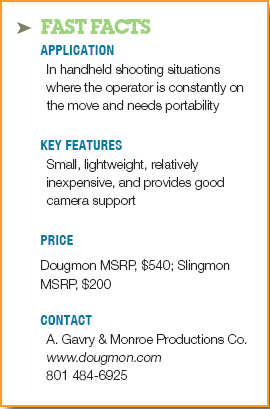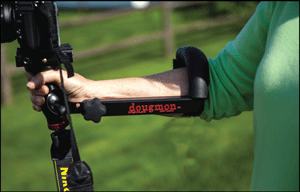Dougmon Camera Support System
When you’re required to shoot for long periods of time without the benefit of a tripod, you must learn quickly how to keep your shots steady so as not to make the viewer ill. Steady shots require three things in my opinion: skill in knowing how to properly balance the camera to keep it steady; strength in your forearm to smoothly navigate through your environment; and having access to a Dougmon.
FEATURES
Designed and created by Douglas Monroe (“Dougmon”—get it?), this “small camera and DSLR solution” allows the user to shoot handheld for an extended period of time with extra support where it is needed most. When used in conjunction with the Slingmon accessory, you can shoot for hours comfortably without needing Popeye’s arms and several cans of spinach.
So, what exactly is a Dougmon?

It’s a camera support system that was designed with documentary, news, wedding and reality TV shooting in mind, and it certainly makes a shooter’s life easier. Your torso only moves so far (some of us have less range than others), and most shouldermounted systems limit you to that range. Extending the Dougmon to monopod mode, you can shoot over your head, or reversing it, almost at ground level.
I immediately knew upon its arrival that the Dougmon had been invented by a shooter. It’s designed to be used by righthanded operators (a left-handed version is in the works), with an adjustable arm that extends to fi t the forearm of any size user and which sports a cushion that straps securely to the operator’s forearm.
The gear arrived in a red and black mesh bag and once its drawstring was opened the fi rst piece of business was attaching the camera to the supplied plate. Two screws are available to fi t most any size camera, and I was easily able to remove the larger screw and set it in a safe place, as the smaller screw was the correct fi t for the Nikon D800 I elected to use to test the Dougmon. There was nothing complicated about attaching the camera. Actually, it was extremely diffi cult not to mount the plate on the Dougmon correctly. An arrow clearly shows the insertion path and a tightening knob secures the plate to the hand mount. There are only three other personal adjustments to make.
The Dougmon is worn with the adjustable bar against your inside forearm, the side that would normally rest against your stomach. This is clearly shown in the instructions, and if you put it on backwards (with the bar on the outside of your forearm), you’ll fi nd that your range of motion is limited. (You want the name “Dougmon” facing you.) An adjusting knob slides the hand grip in or out, to accommodate any length of forearm. A padded, adjustable strap at the end wraps around your forearm for a snug fi t. The third and last adjustment is a knob at the base of the hand grip which controls the tension to the friction ball in the center of the hand grip. Loosening this gives you the range of motion needed for shooting. When attached to your arm, the Dougmon has the look of a robotic stabilization device, or at least something mildly bionic.

The Dougmon support device The Slingmon is a must-have addition to the Dougmon, as it lessens user fatigue when shooting for extended periods. Slung over the opposite shoulder of the Dougmon, a gray, padded pouch rests against your side with the sturdy, lined, black pouch facing outward. With the Dougmon removed from your forearm, extended and lowered as if a monopod, it rests comfortably in the Slingmon, thus taking the weight off your forearm. With the Dougmon adjusted to the shooter’s eye height, the Slingmon is a comfortable device that holds the camera securely and allows the operator to shoot either via the eyepiece or the camera’s LCD.
IN USE
I was anxious to try out the Dougmon on a shoot I had set up on a beach in Maine. A Nikon D800 with a 24 to 70 mm f-2.8 lens was the DSLR of choice for the shoot, and handholding a camera of this girth quickly becomes uncomfortable. I found that with the camera mounted to the Dougmon, it was as easy to pan, tilt, and maneuver it as if it weren’t attached to anything. I really felt no constraints on camera movement. And ulike other stabilizing devices, it took no practice to use the Dougmon properly.
With the Dougmon, most of the camera’s weight is distributed over the length of your forearm. Although practice is not required, stamina is—as it should be when shooting anything. You are not tied down to a tripod, and although the images are not “Steadicam smooth,” they do look quite good for handheld shots. Running and jumping over rocks among the waves was simple; however, the stares from the beachcombers were disconcerting when they saw me doing this. Although after a few moments of watching me, they realized what the Dougmon was meant for and went on with their business.
The Slingmon is a lifesaver when used with the Dougmon. After being involved in beach shooting for more than an hour, the Slingmon really came in handy, providing me with a place for the camera system to be put in “pause” for a moment.
While the Dougmon system isn’t the perfect end-all in handheld shooting, it is extremely easy to use and master. And as with any tool in our industry, it does have a specifi c purpose. If you really aren’t able to shoot a smooth handheld shot to save your life, then the Dougmon and Slingmon will make you a smoother shooter. On the other hand, if you’re blessed with the ability to shoot handheld and to hold the shot steady, then this combo will allow you to do it for extended periods of time while allowing your smooth expertise to shine through.
SUMMARY
If you need to shoot without a tripod for extended periods of time and must be mobile, the Dougmon and Slingmon will allow you to accomplish such a feat quite easily. The comfortable device is inexpensive, mounts or dismounts in moments, and has the shortest learning curve of any such device I’ve encountered in quite a while. Rarely in this business does “one size fi ts all” apply, but for the Dougmon, it really does.
Chuck Gloman is chair and associate professor of the TV/Film department at De- Sales University. He may be contacted atchuck.gloman@desales.edu.
Get the TV Tech Newsletter
The professional video industry's #1 source for news, trends and product and tech information. Sign up below.
Chuck Gloman is Associate Professor with the TV/Film Department at DeSales University.

